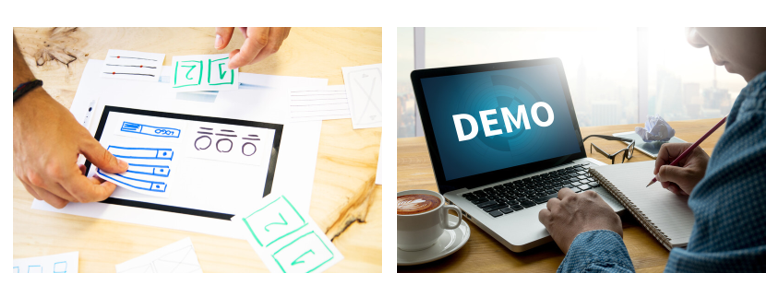
Adjusting Human Factors Processes for COVID-19: Remote Creativity
New COVID-19 measures to protect our safety limit some human factors usability studies from being executed through traditional in-person facilitation. This blog identifies creative ‘COVID-19 friendly’ solutions to combat logistical hurdles for human factors research and evaluation activities supporting medical device product development.
Key Opinion Leader (KOL) interviews
As part of preliminary research completed during the early phases of product development, Key Opinion Leader (KOL) interviews provide invaluable user-centered feedback and data, which drives effective system design. Interviewing subject experts provides first hand insights and experiences that directly guide and validate system design direction and decisions. Traditionally, these interviews are done in person; however, they are equally as effective when conducted remotely.
To conduct a KOL interview remotely, hold the session either over the phone for an audio call, or through computer interaction for a video conferencing session. Generally speaking, KOL interviews include conversation surrounding medical devices, products or systems they currently use that may be relevant to the device in question. Remote KOL interviews using video conferencing provide the opportunity to view products or features during the discussion.

Site visits
Hand-in-hand with KOL interviews, site visits are a form of human factors contextual research. A site visit is coordinated during preliminary research to gather use environment data relating to the intended use environment of the system in development. While visiting sites in person is not a possibility during COVID-19 restrictions, a video conferencing session can provide feedback and information to the project team. Similar to a KOL interview, the video conference call session can be conducted between the facilitator of the session and the contact or KOL from the site visit environment.
Environmental characteristics
If possible, the individual within the site visit location should give a virtual tour through the facility, or send a video to the team prior to the meeting. Instead of being able to make observations and deductions of the environment first hand, the facilitator can create visual scales of certain characteristics of the use environment, such as lighting, noise, clutter, colors and architectural styles. These scales can then be presented to the site visit contact for them to select the most appropriate visuals based on first hand experience of the environment.

Working through the categorization of these environmental characteristics during a remote session provides the facilitator with information similar to that which they would normally gather through an in-person site visit. To ensure the session is set up to capture as much information as possible, interview questions should target specific characteristics of the use environment which the contact may not think of describing. Questions such as, “What other devices, tools and systems are within the room? Can you show us pictures of what these systems look like?” will supplement the personal observations made by the facilitator in an in-person site visit.
Formative usability evaluations and tests
Also challenged by social distancing guidelines is the planning and execution of human factors formative usability evaluations and tests. Traditionally, these sessions are executed in person, with a facilitator leading the session through scripted testing tasks, with one participant at a time in a chosen testing environment. The scope of these studies range from evaluating the user-interface of one or several sub-system components, to the system as a whole.
System level studies may be quite challenging to execute remotely due to the logistical challenges of sending the participant all required testing supplies and recording equipment. An exception is the execution of studies evaluating sub-system components such as a Graphical User Interface (GUI) prototype. This is not only feasible, but the study may benefit from the structure of a remotely planned activity.
Participant recruitment
Recruitment for a remote formative study can follow the standard recruiting practice. We have successfully recruited participants through social media platforms such as Facebook and Twitter. Depending on the nature of the study, a survey is created to screen applicants for certain characteristics, such as age, gender, and proficiency in variable fields (English, reading, technology etc.). Use an online survey tool such as SurveyMonkey to streamline the process. Following the review of completed surveys, and in similar fashion to a standard formative study, the facilitator should reach out to selected participants to confirm their eligibility and availability for the remote session. Unlike a traditional in-person formative session, the facilitator should plan to include a preliminary session with the participant to assist them in setting up and preparing for the study. Care should be taken during this time to coordinate the recording hardware and software. Organize the layout of the participants’ environment to ensure the right imagery is captured to support subsequent analysis. During the planning phase, ship any required testing articles to the test participant.
Take care to ensure there is a sufficient cleaning and disinfection protocol in place to stop the spread of any viral contaminants during the transport of testing prototypes to and from the participant’s location. To ensure the cleaning protocol adheres to required practices, we recommend that the proposed protocol be shared and reviewed with the appropriate regulatory body (or representative) in order to confirm that sufficient safety precautions have been met.
With the current environment created by COVID-19, we are in the unique situation where we are not only concerned about participant safety during the use and handling of prototypes, but also the safety of the facilitator during the handling of the testing materials following the session. For this reason, rapid prototyping techniques such as 3D printing and foam modeling provide a significant benefit for the organization of remote sessions. It may be prudent to allow the participant to keep or dispose of the prototypes to mitigate the need for them to clean or disinfect any materials before returning. Formative evaluations that could use this method include the anthropometric and ergonomic analysis of specific user-interface components, such as handles, buttons, module sizes and forms.
GUI prototyping
For GUI prototyping, we have utilized Figma, a collaborative tool intended for GUI design. These prototypes can be shared with test participants through a URL, so the user can test the prototype on the device they have available (laptop, desktop, or smartphone) without having to travel anywhere specific for the study. To execute a GUI prototype study remotely, the facilitator sends the participant a link to the prototype, with a quick guide to setting up and completing the study.

For GUI prototype studies, it is important that the facilitator can observe what the participant is experiencing on their screen during the session. The facilitator can set up a video conferencing call that has screen sharing capability to watch the participant use the prototype in real time. Alternatively, the facilitator could send the participant a link to a user friendly screen capture tool (such as Flashback Express), for them to record and save the session as a video file. The participant can send the file to the facilitator following the completion of the testing activities.
In essence, the solution to the obstacles posed to product development by COVID-19 lies in creatively utilizing remote connection video and audio conferencing software. Now more than ever, there is a need for innovative thinking that challenges previously accepted standards of practice. This need drives our determination to push forward with our work and ensure that activities to incorporate user-centered feedback are executed in a safe and effective manner.
Hannah Rusak-Gillrie is a Human Factors Engineer at StarFish Medical. She is a graduate of University of Victoria and is a co-author of Simulation-Based Mock-Up Evaluation of a Universal Operating Room.
Image: ID 41389868 © duiwoy55 | Canstockphoto.com
Read how StarFish Medical led a consortium that created a Ventilator 2.0 therapy device in record time.